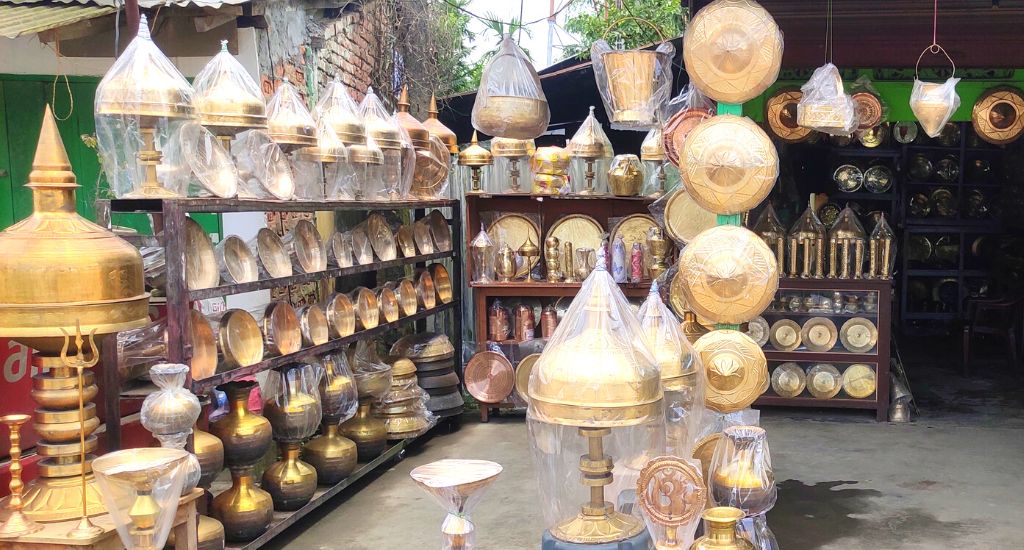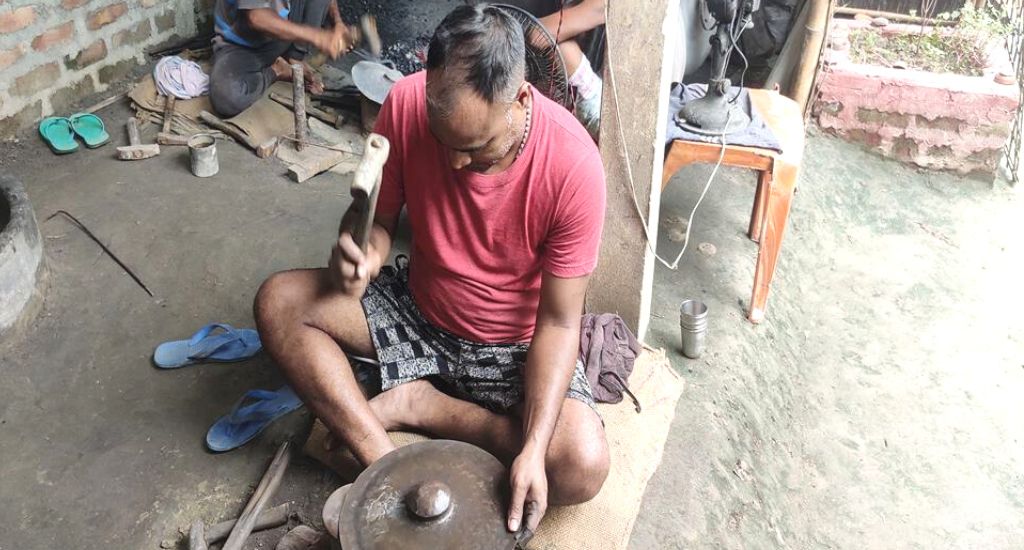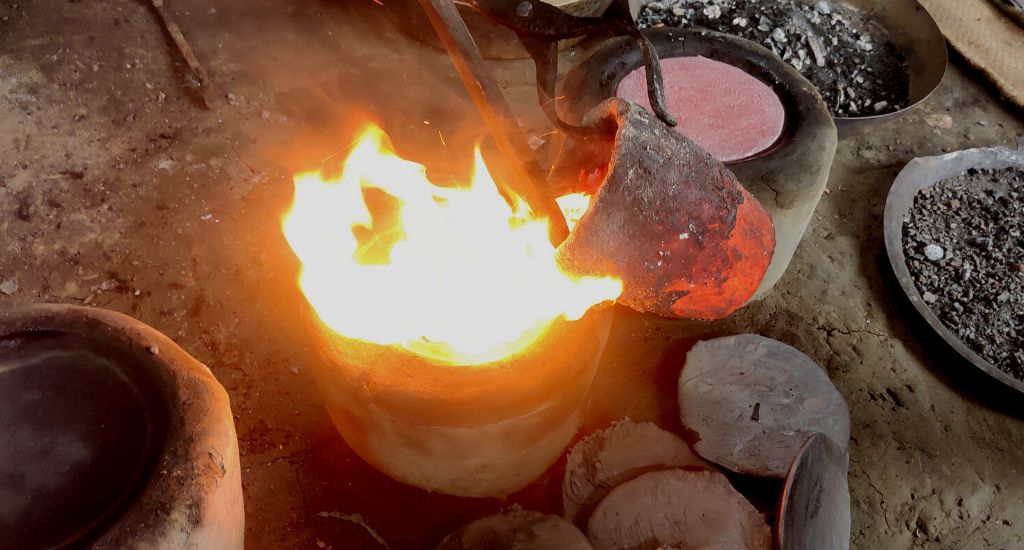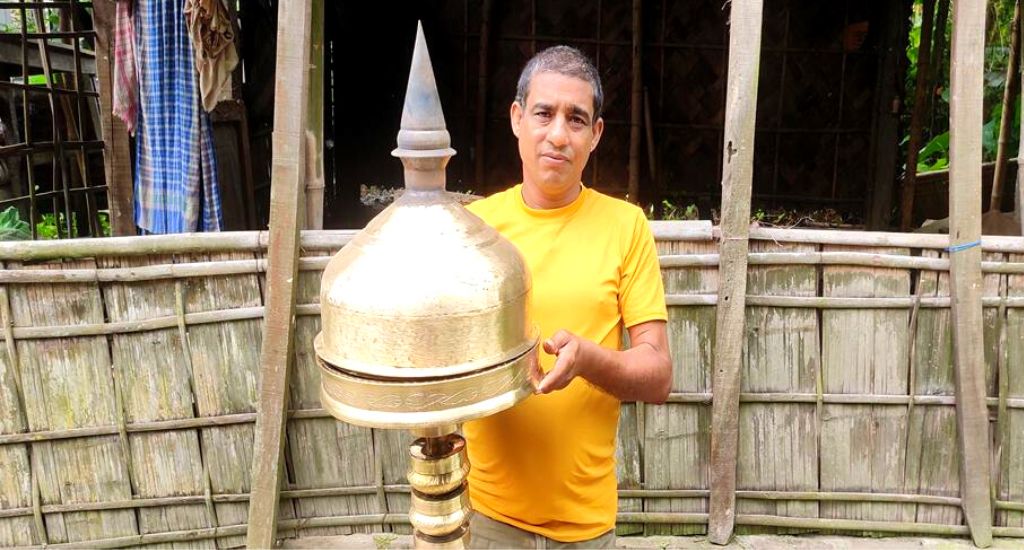
Bell metal fires fading out in Assam
The rising cost of raw material, coupled with the pandemic and stiff competition from other states, is dealing a blow to the ancient brass and bell metal industry of Sarthebari, Assam.

The rising cost of raw material, coupled with the pandemic and stiff competition from other states, is dealing a blow to the ancient brass and bell metal industry of Sarthebari, Assam.
Dhanjit Deka spends around 10 hours every day before a small but fierce fire, manufacturing bell metal utensils. He makes pan bata (bowls mounted on a base) that are used for offering areca nuts to guests in Assamese households.
The 40-year-old is among the 10,000 artisans who live in the ancient Sarthebari village of the Barpeta district, which holds the distinction of housing one of the oldest handicraft industries in the northeastern state.
The artisans make utensils like kalash (water pot), sarai (a platter or tray mounted on a base with a cover on the top), kahi (a food dish), bati (bowl), lota (a water pot with a long neck) and tal (cymbals).

But their ancient technique is under threat on several fronts.
Situated around 70 kilometres from the state capital Guwahati, Sarthebari is a cluster of five villages with around 10,000 artisans working in 400 units.
Historians believe that Sarthebari villagers began making bell metal utensils around 350 BC.
“We do not know the exact time, but it is generally believed to have started even before Jesus Christ. There is evidence available from the 7th Century AD when Kumar Bhaskara Varman, the king of the Varman dynasty, ruled Assam (then Kamarupa). He gifted the utensils manufactured here to King Harshavardhana, the King of the Vardhana dynasty, during his coronation,” says Naren Patgiri, associate professor, department of history, Gauhati University.
“Even the eminent Chinese scholar Hiuen Tsang, who visited Assam, was gifted these utensils by Kumar Bhaskara Varman. But the British revenue policy destroyed the industry as they closed (off) the business of Sarthebari with Bhutan and Tibet to promote their own products,” he adds.
The soft-spoken Deka says brass and bell metal artisans like him are commonly called kahars, which is the Assamese word for kumhar (blacksmith). Bell metal is a form of bronze metal, which gets its name because of the bell sound it generates when struck.

“The copper and zinc utensils made by us are in demand mostly in upper parts of the state because of the large Hindu populations that use them in religious rituals. These are also given by parents to their daughters during marriage ceremonies,” says Deka.
But the craftsmen say that they are facing losses because of the increasing cost of raw materials.
“Raw material cost has more than doubled in the past four years. Copper now costs around Rs 750 as against Rs 320, zinc costs around Rs 2,700 compared to Rs 1,200 while the price of brass has jumped to Rs 450 from Rs 250 in the past four years,” pointed out Bijay Bhuiyan (28), a young craftsman.
While the raw material is procured by the wholesaler – and not the artisans themselves who just manufacture the products – the wholesaler has been passing his loss onto the artisans by refusing to increase their wages.
But that is not their only worry.
Our technique has remained unchanged for the past several centuries because we want to preserve our age-old tradition.
“The Goods and Services Tax (GST) raises the price of the product. Foreign buyers are often not ready to buy the products at a higher price. The stiff competition that we get locally is also affecting our business,” pointed out Bhaskar Jyoti Tamuli, a shareholder of the Assam Co-operative Bell Metal Utensils Manufacturers Society Limited.
Indeed, the artisans face strong competition from craftspeople in other states. Muradabad, a city in Uttar Pradesh, is famous for brass products.
But they use machines for production.

“We still make handmade products to maintain originality. Our technique has remained unchanged for the past several centuries because we want to preserve our age-old tradition. But our reluctance to shift to a modern method of production has been taking a toll on our livelihood,” Bhuiyan said.
Used bell metal objects, like cups or plates, are broken into pieces and then put in the burning fire.
When it becomes liquified the hot molten is poured into an iron container, taking that shape as it cools. The metal ingots are then hammered again for the shape.
The fate of brass metal product manufacturers who work in the same area is no different.
They are known for making sarai that are mostly used for felicitating the guests during public events and also kept in monasteries as donation boxes.
“We still use traditional methods for polishing the utensils unlike the machines that are used nowadays. Despite the rising raw material cost, we cannot hike the price as nobody would buy it and people would switch over to cheap products available in the market,” said Krishna Das (44), another craftsman.
Besides these ongoing worries, many craftsmen are still reeling from pandemic-induced restrictions that also dealt a heavy blow to their livelihood.
“The bell metal utensils are used by Buddhist monasteries in neighbouring Bhutan. The bulk buyers from there used to come here directly to buy these items and then used to sell them in Bhutan. We used to earn good revenue from them,” said Manoj Tamuli (38), a craftsman in Sarthebari.

“But the pandemic changed everything. The Bhutanese government clamped border restrictions down on us and people were stopped from venturing outside. We lost a chunk of our business. It’s yet to get normal till now.”
“Before the pandemic, we used to supply around 500 kg of products every day to neighbouring countries like Bhutan and Nepal, but the restrictions have destroyed us,” said Tamuli.
Every day, as dusk envelopes the sky, work in Sarthebari is called off by extinguishing the burning fire.
Deka is reflective.
He knows the problems his people and his craft face are huge, perhaps insurmountable. He supposes modernising is a potential way forward, but he cannot bear to think of throwing away centuries of bell metal tradition.
“The future is uncertain. We know that change is the only way for survival, but this art carries the hard work and emotions of our ancestors, which we are carrying forward. A slight change will rub away its glorious past.”
The lead image at the top of this page shows bell metal utensil being made in a fire (Photo by Gurvinder Singh)
Gurvinder Singh is a Kolkata-based journalist.